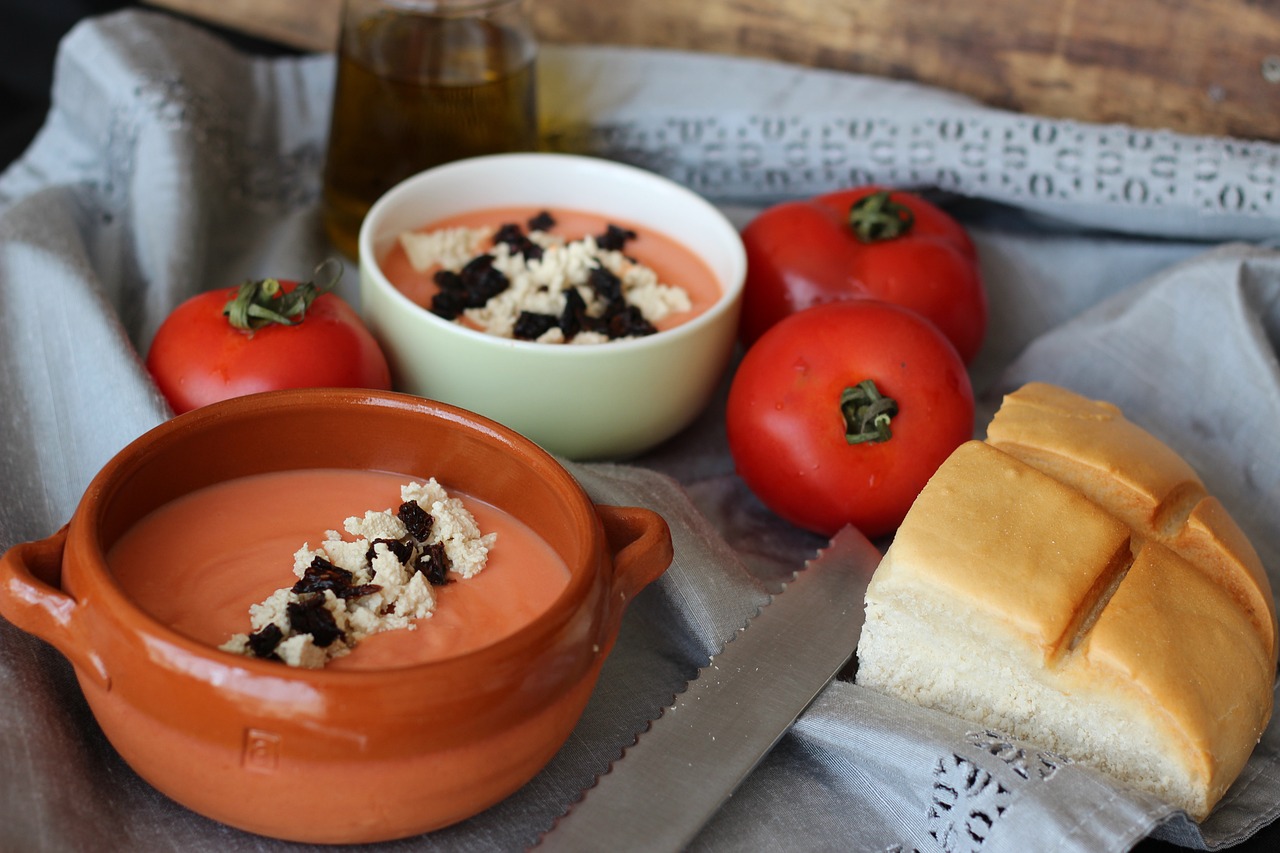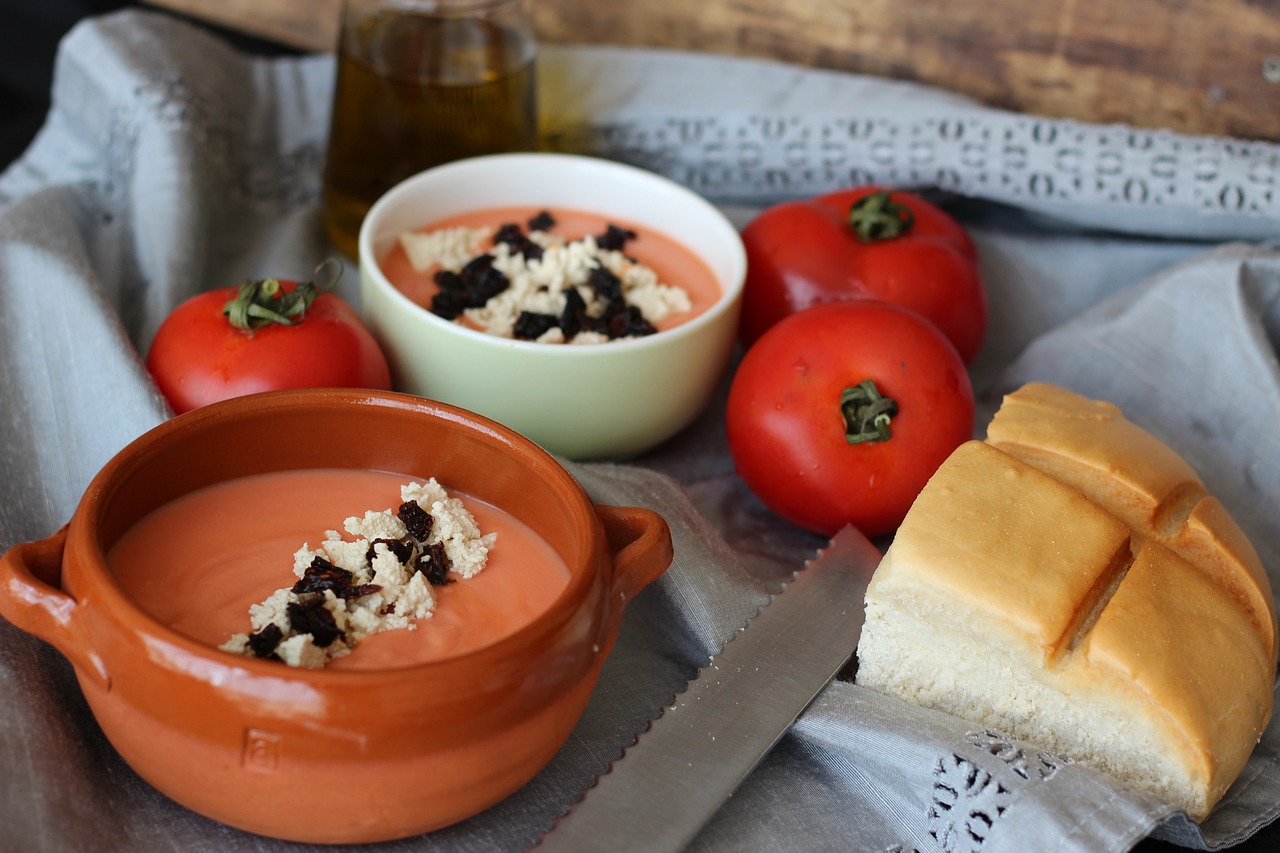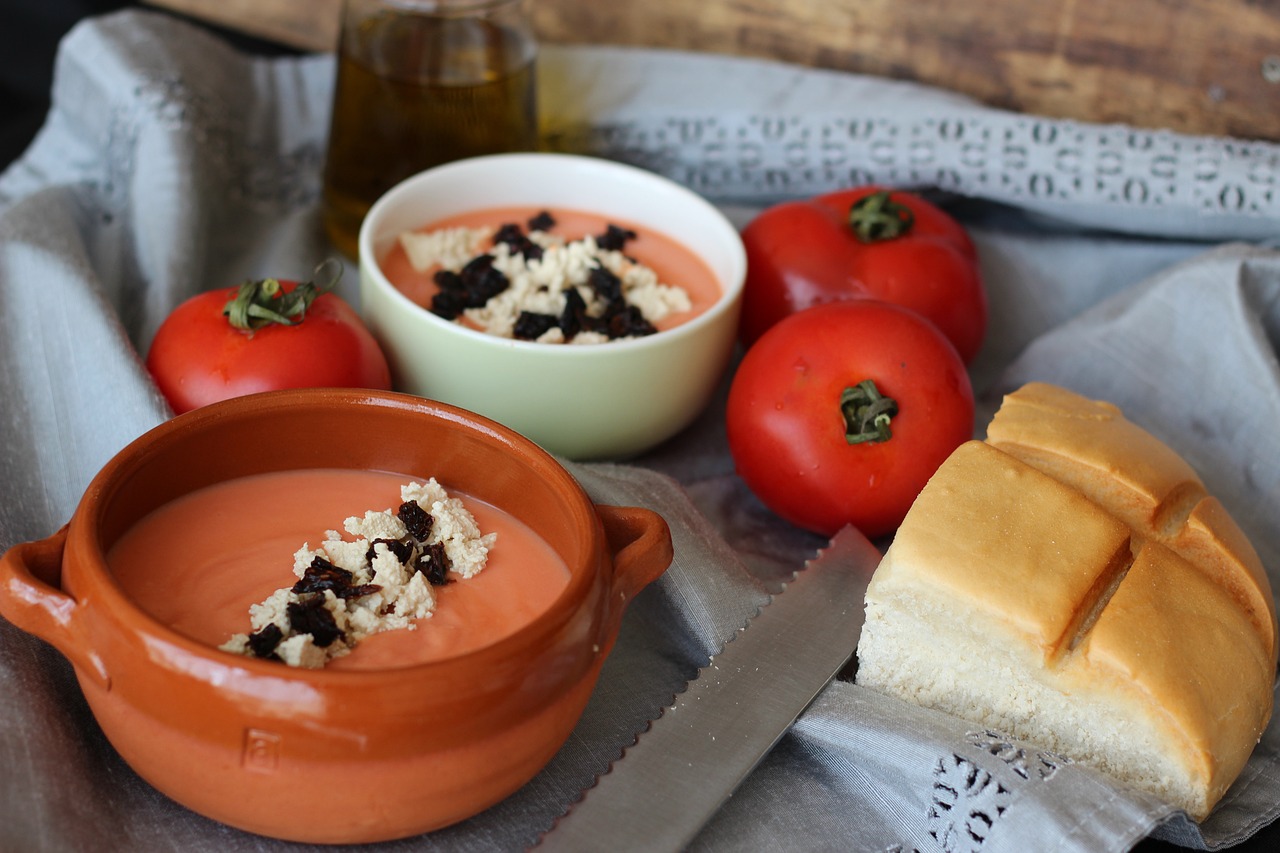Salmorejo: Creamy Spanish Tomato and Bread Soup

Salmorejo is a delightful and creamy Spanish soup that combines the vibrant flavors of ripe tomatoes, crusty bread, fragrant olive oil, and pungent garlic. This cold soup is a refreshing and satisfying dish, perfect for warm summer days or as a light meal any time of the year.
- Originating from the sunny region of Andalusia in southern Spain, Salmorejo has a rich history dating back centuries. It is deeply rooted in Spanish culinary tradition and is a beloved dish enjoyed by many.
- The simplicity of the ingredients used in Salmorejo highlights the quality and freshness of each component. Ripe tomatoes provide a burst of sweetness, while the bread adds body and texture to the soup. The olive oil infuses richness, and the garlic lends a robust flavor profile.
- To prepare this traditional soup, the ingredients are blended together to create a smooth and velvety consistency. The result is a vibrant red soup that is both visually appealing and delicious to taste.
Whether served as a starter, a light meal, or as part of a tapas spread, Salmorejo offers versatility in both presentation and flavor. Garnishes such as hard-boiled eggs, jamón ibérico, or a drizzle of olive oil can elevate the dish and add layers of complexity.
For those looking to put a modern twist on this classic recipe, there are endless possibilities to explore. From incorporating ingredients like avocado or shrimp to experimenting with different herb garnishes, Salmorejo can be customized to suit individual tastes and preferences.
History and Origins
Salmorejo, the creamy Spanish tomato and bread soup, has a rich history and fascinating origins that date back to the region of Andalusia in southern Spain. This traditional dish is not just a soup; it's a cultural icon that reflects the essence of Spanish cuisine. Imagine the warm sun of Andalusia ripening the tomatoes and infusing them with flavor, while the aroma of garlic and olive oil fills the air.
The roots of Salmorejo can be traced to humble beginnings, where simple ingredients like ripe tomatoes, day-old bread, and garlic were transformed into a culinary masterpiece. Over the years, the recipe has evolved, adapting to modern tastes while still preserving its authentic essence. Each spoonful of Salmorejo carries with it centuries of tradition and innovation, making it a true gastronomic delight.
As you delve into the history of Salmorejo, you'll uncover the influence of various cultures that have shaped this beloved dish. From the Moors who introduced tomatoes to Spain to the creative genius of Spanish chefs who elevated it to gourmet status, Salmorejo is a testament to the blending of flavors and traditions.
Picture yourself walking through the cobblestone streets of Andalusia, where every corner holds a hidden gem of culinary history. The vibrant colors of the tomatoes, the earthy aroma of the bread, and the pungent scent of garlic all come together in perfect harmony to create Salmorejo, a dish that transcends time and borders.
Ingredients and Preparation
When it comes to Salmorejo, the magic lies in its simple yet flavorful ingredients. To prepare this creamy Spanish tomato and bread soup, you will need a handful of key components that come together to create a symphony of taste. Let's delve into the essential ingredients and the step-by-step preparation process that will elevate your culinary skills.
First and foremost, ripe tomatoes take the spotlight in Salmorejo, infusing the soup with a burst of freshness and vibrant color. These juicy tomatoes serve as the foundation of the dish, providing a rich base of flavor that sets the tone for the entire recipe.
Next up, day-old bread plays a crucial role in achieving the velvety texture that defines Salmorejo. The bread, soaked in water and then squeezed dry, acts as a thickening agent, giving the soup its signature creaminess and body. It's amazing how such a humble ingredient can transform a simple dish into a culinary masterpiece.
Olive oil, often referred to as liquid gold in Spanish cuisine, adds a luxurious touch to Salmorejo. The fruity and robust flavors of olive oil not only enhance the taste of the soup but also contribute to its silky smooth consistency. A generous drizzle of high-quality olive oil is the finishing touch that elevates Salmorejo to a gourmet level.
To balance out the sweetness of the tomatoes and the richness of the olive oil, garlic brings a pungent and aromatic note to the soup. Whether minced finely or crushed into a paste, garlic infuses Salmorejo with a depth of flavor that lingers on the palate, leaving a satisfying and memorable taste experience.
Now, let's walk through the preparation process of Salmorejo. Begin by blending together the ripe tomatoes, soaked bread, olive oil, and garlic until smooth and creamy. Season the mixture with salt to taste, adjusting the flavors until they harmonize perfectly. Once the soup reaches the desired consistency, refrigerate it to chill and allow the flavors to meld together.
Before serving, garnish the Salmorejo with a drizzle of olive oil, a sprinkle of diced hard-boiled eggs, and a dash of chopped ham or crumbled crispy bacon. These toppings not only add visual appeal but also provide contrasting textures and flavors that complement the soup beautifully.
Now that you have mastered the art of Salmorejo preparation, it's time to savor the fruits of your labor. Whether enjoyed as a refreshing starter on a hot summer day or as a light meal accompanied by crusty bread, this creamy Spanish tomato and bread soup is sure to delight your taste buds and transport you to the sun-drenched streets of Andalusia.
Serving and Presentation
When it comes to serving and presenting Salmorejo, there are various creative ways to showcase this delightful Spanish soup. Whether you're looking to impress guests at a dinner party or simply elevate your dining experience at home, the presentation of Salmorejo can make a significant impact. Let's explore some ideas on how to serve and present this creamy tomato and bread soup:
- Traditional Bowl: Serve Salmorejo in a classic soup bowl for a cozy and familiar presentation. The vibrant orange color of the soup against the white bowl creates a visually appealing contrast.
- Garnishes Galore: Elevate the visual appeal and flavor profile of Salmorejo by adding an array of colorful garnishes. Consider topping the soup with diced hard-boiled eggs, crispy jamón serrano or ibérico, chopped fresh herbs like parsley or chives, and a drizzle of extra virgin olive oil.
- Tapas Style: Serve Salmorejo in small individual glasses or shot glasses for a stylish tapas presentation. This allows guests to enjoy a taste of this refreshing soup without committing to a full bowl.
- Creative Plating: Experiment with different plating techniques to create visually stunning presentations. Use a squeeze bottle to drizzle olive oil in artistic patterns on the surface of the soup or use a toothpick to create swirls for an elegant touch.
- Accompaniments: Pair Salmorejo with an assortment of Spanish tapas such as crispy breadsticks, olives, Manchego cheese, or marinated anchovies for a complete culinary experience. The combination of flavors and textures will delight your taste buds.
Remember, the way you serve and present Salmorejo can enhance the overall dining experience and leave a lasting impression on your guests. Get creative, experiment with different styles, and have fun showcasing this classic Spanish dish in a new light!
Variations and Modern Twists
When it comes to Salmorejo, the possibilities for variations and modern twists are as endless as the Spanish sunsets. Chefs and home cooks alike have embraced the traditional recipe and added their own creative flair to this beloved dish. From unique ingredients to innovative presentations, Salmorejo has undergone a culinary evolution that continues to surprise and delight taste buds around the world.
One popular variation of Salmorejo involves the addition of fresh fruits such as strawberries or watermelon, which not only bring a sweet and refreshing contrast to the savory flavors but also elevate the dish to a whole new level of sophistication. The subtle sweetness of the fruits complements the tangy tomatoes and garlicky undertones, creating a symphony of flavors in every spoonful.
For those looking to add a textural twist to their Salmorejo, incorporating crunchy toppings like crumbled crispy ham, toasted almonds, or even fried capers can provide a delightful contrast to the smooth and creamy base. These crunchy elements not only add a satisfying crunch but also introduce a depth of flavor that keeps each bite interesting and dynamic.
If you're feeling adventurous, why not explore the world of flavored oils and vinegars to give your Salmorejo a modern twist? Infusing olive oil with herbs like basil or rosemary, or experimenting with aged balsamic vinegar drizzled on top, can take this traditional soup to new heights of gourmet indulgence. The interplay of different flavors adds complexity and richness, turning a simple dish into a culinary masterpiece.
Another creative approach to modernizing Salmorejo is by experimenting with alternative bread options. While the classic recipe calls for day-old bread, you can switch things up by using artisanal bread varieties like sourdough, rye, or even cornbread. Each type of bread brings its own unique texture and flavor profile, allowing you to customize your Salmorejo to suit your preferences and taste preferences.
When it comes to presentation, the sky's the limit with Salmorejo. Whether served in elegant shot glasses as a chic appetizer, drizzled artistically with swirls of olive oil, or topped with a colorful array of edible flowers, the visual appeal of this dish is just as important as its taste. Experiment with different plating techniques and garnishes to create a feast for the eyes as well as the palate.



 HazalVardal
HazalVardal 





